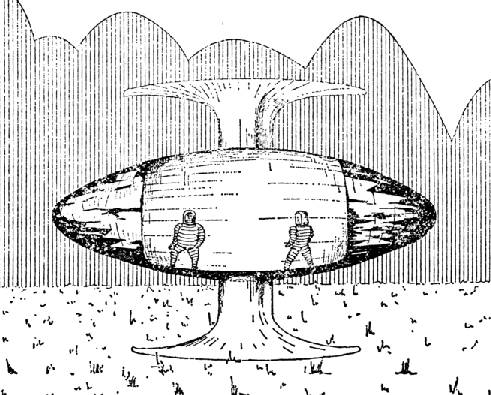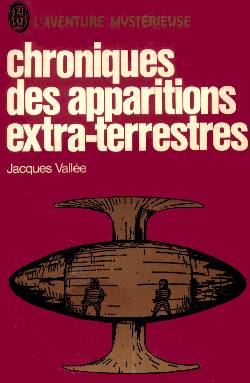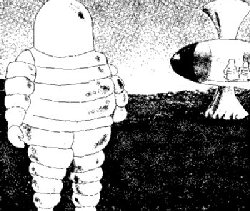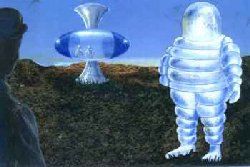On July 31, 1968, at approximately 9 hours in the morning, Luce Fontaine, a creole, a "drunk cowboy" according to sources making fun of the event and a farmer married to a shcoolteacher according to other sources, 22 years old, was gathering grass for his rabbits in a small clearing, at the center of an acacias wood at the location"Le Tampon" in the Plain of Cafres, Reunion island.
He said to have seen there, during about fifteen seconds, an object of oval shape, with a translucent center and dark blue ends, stationed four or five meters above him at a distance of 25 meters. The machine measured some 5 meters broad and 2 meters 50 height.
Of blue and white color, the object emitted a raw whitish light compared with that of an welder. Sorts of large feet of metal were above and below the machine:
 Drawing in J.P. Lavilgrand's report. |
In the center of the craft, behind the translucent part, Luce Fontaine saw two characters of the humanoid type, of approximately 90 centimetres in height, dressed from the feet to the head of a kind of bumpy cosmonaut suit, which he called the "Michelin babas" since they resembled the famous mascot of the tires manufacturer. The two beings carried sorts of helmets which partially masked their face.
At the end of a few seconds, the two beings seemed to realize the presence of Luce Fontaine, they turn their back to him and the machine disappears in a few seconds in a dazzling flash of light and a hot air blast.

|
Illustration relating to this cas as cover to a book by Jacques Vallée. |
Luce Fontaine, according to various local journalistic sources, is presented sometimes as "a farmer considered as sober and honest", or "a cowboy who was returning of a party where alcohol abunded." The accounts do not specify if it is him who spontaneously went to find the Gendarmes to report what he saw or if the gendarmes came to challenge the man about a spread story, in any event, the Gendarmes of the island noted his statement to them as:
"I saw during about fifteen seconds an object of ovoid shape stationed at four or five meters above the ground. The object emitted a light like that of an electric welder. It had four to five meters in diameter and approximately two meters and a half in hieght. It was blue and white in its upper and lower parts. I was incomodated by the powerful light, but I could nevertheless distinguish, behind a blue screen, two characters who seemed to me to measure approximately 90 centimetres. The two characters were in an astronaut's suit."
"They resembled two "Michelin Babas", one of them was showing his back whereas the other faced me. When these two kind of cosmonauts saw me, there was a white flash and the apparatus flew away."
His interrogation by the Gendarmerie, within the framework of the investigation directed by Gendarmerie Captain Maljean, of Saint-Pierre, did not end in the publication of a commonplace explanation nor in the exposure of a hoax and the reports are not classified.
After the investigation by the Gendarmerie, it was the director of the departmental service of fire and help, Captain Léopold Legros, who had some knowledge as regards nuclear power, chemistry and biology, who realized that Luce Fontaine's hat and trousers were radioactive in proportions higher than the natural rates. He had used the detection equipment of Gillot airfield to that effect.
Legros then inspected the sighting's premises and also detected an abnormal radioactivity there, on six specific points aligned three by three on the ground. In addition, Luce Fontaine had a bleeding nose during the eight days which followed his observation, but there was no other noted consequence on his health.
J.P. Lavilgrand, of Daint-Denis de la Reunion, was the first "civilian" ufologist to learn about the case and he published a report, followed by a report by Mr. Albany of the GEPA ufology group. Captain Legros told J.P. Lavilgrand about the radioactivity measured on the site:
"On a radius of five meters around the point flown over by the UFO, eight points of radioactivity caught our attention. On grass tufts, on stones, we detected up to 60 milliRöntgens."
These measurements are not alarming, but quite abnormal. J.P. Lavilgrand furthermore pointed out that the measurements were made 10 days after the events, and that the abundant seasonal rains might have washed up the ground. He also noted the statement of Luce Fontaine, as follows:
"I was at kilometer 21 in a small clearing in the center of a wood of acacias. Bent towards the ground, I collected grass for my rabbits that morning, when I suddenly saw in the clearing a kind of oval cabin 25 meters away of me, hovering at 4 or 5 meters of the ground. Its ends were dark blue, the center was clearer, more transparent, a little like the windshield of a 404 car. Above and below, there was like two feet of brilliant metal glass."
"In the center of the cabin, two individuals, stood with their backs turned towards. That of left turned the head and thus faced me. He was upright, small, 90 cm approximately, wrapped feet to head in a kind of suit like the Michelin man. The one at my right-hand side simply turned the head towards me, but I nevertheless had time to glimpse on his face, partly masked by a kind of helmet."
"Both then turned their backs at me, and there was a flash as violent as that of the electric spark of a welding machine. All became white around me, a strong heat came, then like a blow of air, and a few seconds later there was nothing any more."
"I then approached the place where the machine had been; there was no trace. This object measured 4 or 5 meters in diameter and 2 meters 50 of height approximately. It was of bluish color, white on the higher and lower parts. I told all that to my wife and to the gendarmes, all believed me immediately."
The story was published in the local press, under the heading: "Flying saucer in the Plain of Cafres? Radioactivity slightly higher than the normal noted on clothing of the single witness, a farmer named Luce Fontaine who claims: "Two Michelin men were in the apparatus"." It then came to the press in mainland France, with numerous articles in newspapers like "Centre-Matin", "Le Courier de l'Ouest", "l'Alsace", "Nice Matin", "Le Provençal", "L'Alsace ", "Nice Matin", "Le Provençal": obviously, the fact that the Gendarmerie had investigated, and the traces of radioactivity, made the journalists more comfortable on wether the event was worthy to be reported.

|
Reconstitutions without credit can be found here and there. |

|
On the very spot of the observation, one of the most famous night clubs of La Reunion was later built, and called "The Flying saucer", and the story is now as much the subject of the gibes in the island as a minor classic of the ufologic literature:
The Flying Saucer: a discotheque in the outer limits
It is the last house on the road of the Plains. In 1958, a named Luce Fontaine, cowboy, returning from a party where there was large amounts of alcohol, saw an unidentified flying object crash on its current site. The myth of the "Flying saucer" was born. Today and for forty years, inhabitants of the four corners of the island and all generations have perpetuated the myth while shaking their hips on java, tango and techno music. A dance hall not like any others, where couples form and split, and forget their daily concerns.
Several more times, and notably a few years later in 1975, the Michelin men and their flying saucer came back to visit the island of La Réunion.